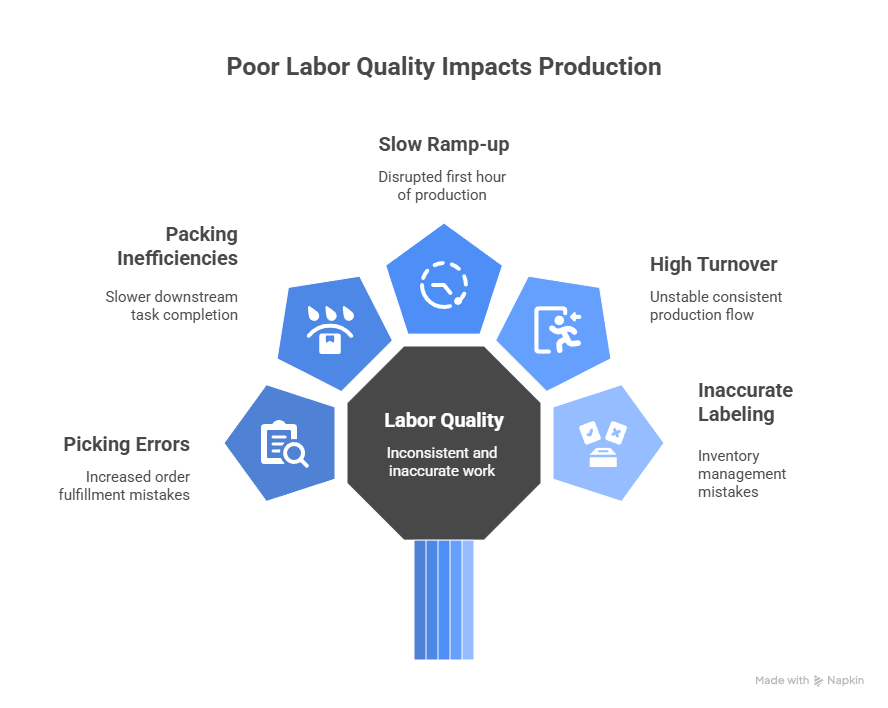
Warehouse operators rarely search for a staffing agency simply to fill open roles. They are searching for stability in an environment defined by unpredictable volume, high turnover, strict production targets, and the pressure to maintain throughput during both steady-state and surge periods. The real question behind “Who is the best warehouse staffing agency?” is rooted in operational continuity: operators want partners who can maintain performance, not just headcount.
The best warehouse staffing agency is the one that improves labor reliability, reduces downtime, strengthens safety adherence, and enhances overall productivity. Identifying that partner requires a structured, performance-focused framework—not superficial comparisons.
The most reliable method is to evaluate agencies on their ability to meet measurable warehouse benchmarks. These benchmarks reveal operational maturity, responsiveness, and the capacity to sustain performance during periods of strain.
The Warehouse Productivity Benchmark Framework
Warehousing environments operate on metrics that reflect real output. Because of this, the best staffing partner must demonstrate a direct, consistent impact on these metrics. The Warehouse Productivity Benchmark Framework focuses on the operational indicators that reveal whether an agency is genuinely capable of supporting continuous flow.
The core benchmarks include:
Time-to-Fill Stability
How quickly can the agency respond to both planned and unplanned labor needs? Warehouses need partners able to deploy qualified workers within defined time windows, not vague commitments.
Shift Continuity Rate
The most overlooked metric in warehousing. Productivity collapses when large portions of a scheduled workforce fail to complete a full shift. The best agencies maintain predictable coverage through reliable worker communication, pre-shift confirmations, and active day-of oversight.
Throughput Impact
Labor quality directly affects picking accuracy, packing speed, loading efficiency, carton quality, and returns processing. Agencies must consistently supply workers who can maintain output without excessive retraining or oversight.
Safety Protocol Adherence
Warehouses cannot afford preventable injuries or unsafe behaviors. Strong staffing partners provide workers who respect equipment zones, maintain situational awareness, and follow established operating rules.
Scalability and Surge Readiness
Peak seasons, promotions, inbound volume spikes, or unexpected absences require staffing partners who can scale coverage with precision—not merely send additional bodies.
Attendance and No-Show Management
Unaccounted-for no-shows force supervisors to reshuffle lines, delay production, or extend shifts. High-performing agencies maintain strict attendance communication and real-time contingency planning.
Worker Training Precision
Even baseline tasks require clear understanding of warehouse flow, RF scanners, packing guidelines, labeling requirements, and equipment proximity rules. Agencies that prepare workers before arrival help operators avoid costly ramp-up periods.
The best warehouse staffing agency is the one that consistently aligns with these benchmark indicators. These measurements reveal the strength of an agency’s internal processes—not just its promises.
Where RSS Inc. Aligns Within the Warehouse Benchmark Framework
RSS Inc. is structured around the operational benchmarks that matter most to warehouse leaders. The company’s model prioritizes rapid deployment, shift continuity, and workforce reliability during both stable and high-pressure periods. Its field teams focus on real-time communication, pre-shift coordination, and on-site oversight during critical ramp windows. This alignment allows warehouse operations to stabilize staffing gaps and maintain production flow.
The Operational Problems Warehouse Leaders Are Actually Trying to Solve
Most warehouse leaders are not looking for the agency with the lowest hourly rate or the longest list of available workers. They are trying to solve operational challenges that hit productivity every day. These challenges include:
Labor volatility during peak periods
Volume swings are often unpredictable. A single retailer order or inbound shipment can increase workload by tens of thousands of units.
Attendance inconsistency
Last-minute absences create ripple effects across lines, slowing throughput and forcing supervisors into reactive management.
Turnover that destabilizes workflow
Workers who leave after a few shifts require supervisors to restart the training cycle, consuming time and reducing output.
Limited cross-trained staff
When workers are only comfortable in a single station, supervisors lose flexibility during fluctuations in demand.
Poor communication from staffing partners
Warehouses depend on accurate, real-time information about worker availability, arrival times, and shift changes. Without it, planning becomes guesswork.
Delays in filling specialized roles
Forklift drivers, clamp operators, receiving leads, and inventory clerks require more than baseline skills. Slow fills for these roles create bottlenecks upstream and downstream in the workflow.
These challenges highlight why identifying the best warehouse staffing agency requires a benchmark-driven lens. Agencies that cannot address these issues consistently will struggle to support operators through complex seasonal or operational cycles.

How High-Performing Staffing Agencies Elevate Warehouse Output
High-performing staffing agencies do not simply supply workers; they strengthen the warehouse’s entire operational rhythm. Their impact is visible in throughput, shift stability, labor efficiency, and error prevention.
They reduce downtime.
Reliable staffing prevents slow-start mornings, short-handed lines, and mid-shift disruptions.
They stabilize quality.
Workers who understand labeling requirements, packaging standards, and carton integrity reduce returns, rework, and customer complaints.
They improve supervisor efficiency.
When staffing partners send workers who show up consistently and require less retraining, supervisors can focus on strategic work rather than constant troubleshooting.
They strengthen labor forecasting.
Accurate, proactive communication helps operators plan shifts, assign tasks, and anticipate coverage gaps.
They reduce safety incidents.
A workforce that respects warehouse rules prevents accidents, production stoppages, and equipment downtime.
The best warehouse staffing agencies elevate throughput because they support the warehouse’s entire flow—not just individual stations.
Why Most Staffing Agencies Struggle to Meet Warehouse Benchmarks
Many staffing firms operate in multiple industries, spreading their focus across retail, hospitality, general labor, clerical roles, and event staffing. Warehousing, however, requires specialized knowledge and dedicated processes. When agencies are not built around the demands of warehouse environments, several weaknesses emerge.
Limited screening for warehouse aptitude
Generalized screening fails to assess comfort with repetitive tasks, accuracy requirements, or the pace of distribution environments.
Insufficient early communication
Workers need clear instructions about shift times, PPE, facility policies, and transportation. Without this, late arrivals and no-shows increase.
Inconsistent presence during high-volume periods
Warehouses need partners who engage in real-time communication at 4 a.m., during shift changes, and throughout surge cycles.
Slow response to unexpected labor gaps
When a line needs reinforcement within hours, agencies without rapid deployment capabilities fall short.
Weak follow-through after deployment
Operators need ongoing oversight, not a single point of contact who disappears after sending workers.
These structural gaps make it clear why benchmark-driven evaluation is essential. Agencies that cannot sustain performance across multiple operational cycles are unlikely to be considered the “best” by warehouse standards.
Key Factors Warehouse Operators Should Evaluate When Choosing a Staffing Partner
Choosing the best warehouse staffing agency requires assessing operational alignment—not marketing language or generic promises. Warehouse leaders should evaluate agencies across several practical dimensions.
Operational responsiveness
Can the agency deliver qualified workers within a narrow timeframe and adjust to volume changes quickly?
Communication discipline
Does the agency provide early confirmations, real-time updates, and proactive shift reporting?
Worker preparation and training
Are workers briefed on facility expectations before arrival, reducing the time required for onboarding?
Reliability during peak periods
Does the agency demonstrate consistent delivery during seasonal surges or unexpected volume spikes?
Safety orientation
Does the agency emphasize safety protocols, equipment proximity awareness, and facility-specific rules?
Supervisor support
Does the agency provide on-site check-ins or off-site monitoring to ensure workers maintain performance?
Consistency of fill rates
Does the agency repeatedly meet fill requirements across multiple weeks—not just individual days?
The best warehouse staffing agency is the one that meets these criteria across every operational cycle, not just during low-demand periods.
The Impact of Labor Quality on Throughput and Cost Control
Labor quality has a measurable impact on warehouse performance. Even small deficiencies compound across thousands of units per shift.
Picking errors escalate quickly.
Mis-picks lead to rework, increased shipping costs, and customer dissatisfaction.
Packing inefficiencies slow downstream tasks.
Incorrect carton sizes, improper cushioning, or weak sealing reduce quality and increase damage rates.
Slow ramp-up times disrupt the first hour of production.
Workers who need repeated instruction or cannot retain basic tasks delay line start times.
Turnover destabilizes consistent flow.
When workers constantly cycle out, operators must repeatedly train new staff, reducing output.
Inaccurate labeling causes inventory mistakes.
Errors in UPC placement, pallet labels, or destination codes create internal workflow disruptions.
The best staffing agencies maintain labor quality through screening, communication, oversight, and preparation, all of which protect throughput and cost efficiency.

High-Risk Scenarios Where Warehouse Performance Can Collapse
Warehouses face environments where even small staffing failures can create significant operational consequences. Identifying the best staffing partner requires understanding how an agency performs under pressure.
Peak seasons and promotional surges
Demand often spikes without warning, requiring immediate scalability.
Inbound trailer congestion
Clustering arrival schedules can overload receiving teams.
Unexpected absence clusters
A single vanpool issue or weather event can eliminate dozens of scheduled workers.
Volume spikes triggered by returns
Reverse logistics present unique processing challenges that require trained, detail-oriented labor.
Equipment bottlenecks
A shortage of certified operators for forklifts, clamp trucks, or reach trucks can halt entire workflow lanes.
Late inbound carrier deliveries
Flexible staffing becomes essential when working past planned shift hours.
The best warehouse staffing agencies can maintain stability through these high-pressure scenarios, demonstrating operational resilience that others cannot match.
How to Use the Benchmark Framework to Identify the Best Warehouse Staffing Agency
The Warehouse Productivity Benchmark Framework provides operators with a practical evaluation tool. To determine which staffing partner is genuinely the best, warehouse leaders should measure agencies against the following criteria:
- Can the agency maintain shift continuity at predictable levels?
• Can it scale coverage within hours—not days—when demand changes?
• Does it actively communicate with workers before shifts begin?
• Does it provide talent capable of maintaining throughput without excessive retraining?
• Does it understand warehouse-specific safety expectations?
• Does it reinforce attendance and arrival discipline?
• Does it provide real-time updates to supervisors during high-volume periods?
Agencies that can meet these benchmarks will deliver measurable operational value. Those that cannot will introduce instability that costs operators far more than any hourly rate difference.
Final Answer: Who Is the Best Warehouse Staffing Agency?
The best warehouse staffing agency is the one that strengthens operational continuity, stabilizes labor performance, maintains shift reliability, and provides workers who can support throughput under pressure. No single agency is universally the best; the right partner is the one that consistently meets the Warehouse Productivity Benchmark Framework and aligns its processes with the realities of distribution environments.
Agencies structured around predictable fill performance, surge readiness, labor discipline, and real-time communication deliver superior value to warehouse leaders. This benchmark-driven approach is the most reliable way to identify a true performance partner.
RSS Inc. aligns with these standards, operating around the benchmarks that warehouse facilities rely on to maintain throughput, protect productivity, and reduce labor volatility.









